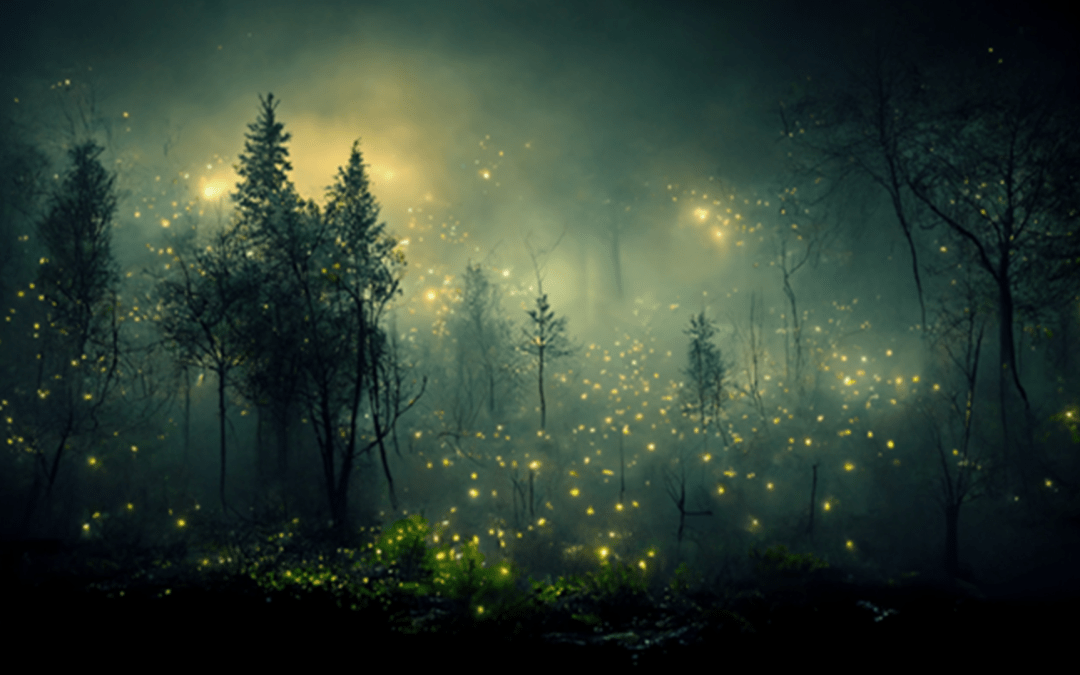Mariam Saleh | Staff Writer
Let’s say you’re watching a movie at home or studying, and suddenly the electricity goes out, and everything’s dark. What’s the first thing you do? Look for some light! You take out your phone and turn on the flashlight. But what if you were stuck in the wilderness, in a pitch-black night, with no phone and nothing to make a fire out of? Unlike humans, some animals that face such a dilemma have developed many adaptations to deal with low-light environments, such as the forest at night or even the deep ocean. Some animals have developed a heightened sense of sound, such as echolocation in bats, using sound to “see” in a sense. Others have adapted by modifying their vision to see in infrared like snakes, or by increasing their optical sensitivity as seen in owls. One particularly interesting adaptation is becoming the light itself! Such is the wonder of bioluminescence.
The word bioluminescence can be broken up into three words: bios meaning “life” in Greek, lumen meaning “light” in Latin, and essentia meaning “to be” or “being” in Latin. It is the ability of an organism to produce visible light for various reasons including vision and attracting mates. Bioluminescence mostly involves Luciferin and/or Luciferase; think of them as the biological alternative to the flashlight on your phone. I say “mostly” because exceptions are bound to be found, such as the Crystal Jellyfish (Aequorea victoria) that uses green fluorescent protein (or GFP for short). It is important to note that bioluminescence and fluorescence are distinct processes, the former involving a chemical reaction with light being a by-product and the latter involving the absorption and subsequent re-emission of a light particle. GFP may be a fluorescent protein itself, but when it absorbs a light particle, it paves the way for a different protein, namely Aequorin, to react and produce blue light, which in turn, signifies bioluminescence.
There are multiple reasons as to why organisms have adopted bioluminescence aside from using it to navigate low-light environments like fireflies. Other organisms use it as a defense mechanism. As much as it sounds counterintuitive to use something that may make you stand out, the logic behind it is pretty sound. It can be used to startle predators in the case of squids and to confuse them in the case of Brittle Stars and Sea Cucumbers.
Some organisms want to stand out. The anglerfish, one of the most popular fish in existence, is known for using a fleshy growth on its head to lure prey in. As soon as the fish chasing the mysterious light satisfies its curiosity, it’s far too late, and it’s ripped to shreds by the anglerfish. The loosejaw anglerfish uses a different strategy. Instead of setting a trap, it uses red light to find its prey. Since fish can only see blue light, it can slip away undetected after a hefty meal.
Bioluminescence has had important applications in seemingly unrelated fields. Scientists have been able to isolate the protein Aequorin, which makes Crystal Jellyfish glow blue after it reacts with Ca2+ ions. This process makes detecting the presence of Calcium ions very easy, especially since the protein selectively reacts with it. Although this method comes with its fair share of problems, one may use this compound to measure the concentration of the ion simply by measuring how much light is emitted. This can be used to detect Ca2+ in cells and even organelles.
Although most animals in the wild try their hardest to avoid being visible, it’s surprising to see that the diversity of life found a way to make visibility a good thing. Ranging from defense mechanisms such as startling, confusing, exposing, and warning predators and offense mechanisms such as prey luring and detection to simply attracting mates, bioluminescence truly is one of the many wonders of life that leave us in utter awe, confusion, and admiration for the mysterious choices nature makes. Even such a phenomenon is not beyond the grasp of humans who have used it in the microscopic world of cells. Truly, nature is beyond fascinating and ingenious!
Sources:
https://education.nationalgeographic.org/resource/bioluminescence/
Ramesh, C., Bessho-Uehara, M. Acquisition of bioluminescent trait by non-luminous organisms from luminous organisms through various origins. Photochem Photobiol Sci 20, 1547–1562 (2021). https://doi-org/10.1007/s43630-021-00124-9
Bonora, M., Giorgi, C., Bononi, A. et al. Subcellular calcium measurements in mammalian cells using jellyfish photoprotein aequorin-based probes. Nat Protoc 8, 2105–2118 (2013). https://doi-org/10.1038/nprot.2013.127


Even small things in nature can lift our spirits and help us find calm when life feels overwhelming. That soft light is a reminder of the balance and peace we all need, especially in our daily routines. Students look for this same sense of balance when they ask to do my online class for me to better manage their time and stress.